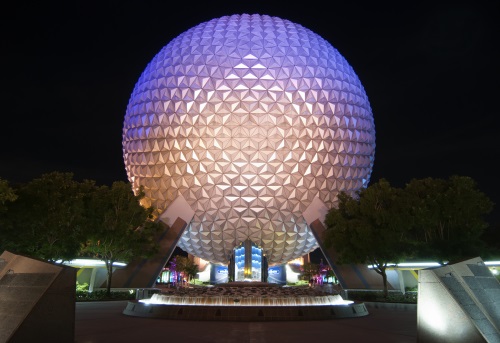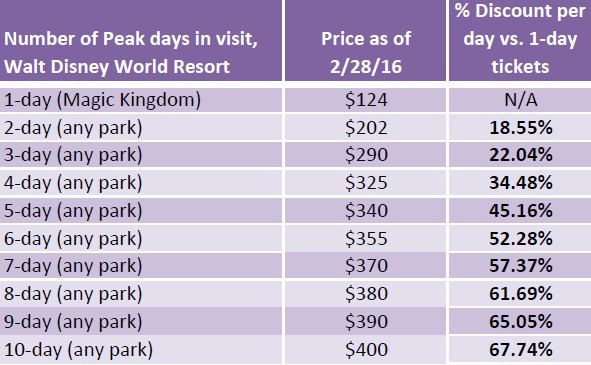Disney announced on February 27 that it was implementing “seasonal pricing” for its California and Florida theme parks. Or was it “surge pricing?” Maybe “variable pricing?” Perhaps it was “demand-based pricing.” It might have been “dynamic pricing.” Media coverage has been inconsistent about the labeling, although fairly consistent in reporting that the Disney price increase means your trip to Disney parks will now cost you more.
Except Disney didn’t actually increase prices across the board—some prices decreased or remained unchanged under the new pricing model. Let’s take a closer look at exactly what Disney did—and did not do.
- The changes at Disneyland and Walt Disney World were different, but neither park increased all prices.
Your view of the recent price increases may differ based on whether the article you read focused on Disney’s California or Florida parks, if it differentiated between the two at all.
Peak prices for Epcot increased less than Peak prices for the Magic Kingdom
(Photo © Urmoments | Dreamstime.com)For both locations, Disney divided the calendar into “Value,” “Regular,” and “Peak” days, with each classification having a different single-day ticket price. Previously, prices had been the same for any day of the year.At Walt Disney World Resort in Florida, the single-day admission price had been $105 for the Magic Kingdom park, and $97 for each of the other parks (Epcot, Hollywood Studios, Animal Kingdom).
Under the new pricing, a single-day ticket to the Magic Kingdom now costs $105 for value days, $110 for Regular days, or $124 for Peak days. For the other parks, prices are now $97 for value days, $102 for Regular days, and $114 for peak days.
As illustrated below, the prices for Value days are unchanged from previous rates. The increases on Regular and Peak days are shown by dollar amount and percentage increase below.

Figure 1
Meanwhile, at Disneyland Resort in California, both parks (Disneyland Park and Disney California Adventure Park) continue to have the same price. Single-day admission to those parks had been priced at $99. As you can see from this chart, Disneyland prices actually decreased for certain days:

Figure 2
The California parks also have more days (83) designated as Value days than their Florida counterparts (44) in 2016.
- Only single-day tickets were affected.
Both Disney locations offer multiple-day passes in addition to single-day tickets. In California, guests may choose a 2-day, 3-day, 4-day, or 5-day ticket option. At the Florida resort, ticket options are available for up to 10 days. Prices of these multi-day ticket prices increased as well. The price of a 2-day ticket, for example, for the Magic Kingdom in Florida had previously been $192; the new price is $202, an increase of $10.However, the introduction of Value/Regular/Peak pricing days applies only to single-day tickets. The cost of a multi-day ticket is the same without regard for when it is used. This is significant for a couple of reasons:- Guests willing to commit to a multi-day visit will be completely unaffected by peak pricing.
As a result, claims like this one made in the New York Post are misleading to the point of being deceptive:“Disney boss Bob Iger on Thursday defended the company’s move to introduce ‘demand pricing’ at its theme parks — a move that could cost a family of four an extra $250 for a three-day visit.”
If the hypothetical family consisted of four people age 10 or over, and if they visited the most expensive park (Magic Kingdom in Florida) on three Peak days, the only way their trip would cost $250 more compared to previous pricing would be if they were foolish enough to pay for three single-day tickets each instead of one three-day ticket per family member.
The prior cost of a 3-day ticket to Walt Disney World parks was $275. The new price is $290, a $15 increase. A family of four’s actual price increase for a three-day stay is therefore only $60, not $250, and has nothing at all to do with demand-based pricing.
- Most guests buy multi-day tickets.
Rich Munarriz, writing for The Motley Fool, seems to have picked up on what other commentators and reporters either missed or chose to ignore:It’s easy for investors to begin drooling at the prospects of summer and holiday travelers paying 18% more this year than in 2015 to get into one of the Florida resort’s four theme parks, but that’s just not the way that things are. On any given day, most guests are on annual passes and, more often than not, multiday passes where they are paying far less on a per-day basis.
As strange as it may seem, making its one-day tickets more expensive pushes guests into spending more for multiday passes to get more bang for their buck. This helps fill up Disney’s growing number of on-site hotel rooms, which now top more than 30,000. If it’s more cost effective to spend several days at Disney World than a single day at the area’s leading attractions, you’re probably going to want to stay at the resort to take advantage of complimentary transportation and expanded hours that are available only to on-site resort guests.
How much more cost-effective are multi-day tickets? This chart shows why no rational person would buy multiple single day tickets where multi-day tickets are an option:

Figure 3
- Guests willing to commit to a multi-day visit will be completely unaffected by peak pricing.
- It’s definitely not surge pricing. It’s not even that dynamic.
Several articles have claimed that Disney has implemented “surge pricing.” However, use of that term, coined by Uber to refer to their particular brand of dynamic pricing, reflects a poor understanding of both Uber’s pricing and of the Disney price increase. As author S.K. writes for The Economist,This surge pricing that Disney is implementing (today) is not actually surge pricing. First, because there is no clear mechanism for supply to increase in response to price. More taxi drivers can flood on to the streets in response to a price rise, but Disney will struggle to offer more park. Second, because the price changes will be nowhere near as dynamic. Prices will be higher at certain times of the year, but parents will not arrive at the gates of Animal Kingdom to find that a glimpse of the massive artificial tree has doubled in price since they left the house.
If it’s not “surge pricing,” then how are we to understand it? It doesn’t appear to be what we at Digonex mean when we say “dynamic pricing,” since the prices seem to have been fixed for the rest of the year rather than being allowed to rise or fall as demand fluctuates.
It is “demand-based pricing” in one sense, though, because predicted differences in demand were the rationale for the creation of three different price tiers. But we would more precisely describe Disney’s model as an example of “variable pricing” in which the price of admission is different across different days, but does not frequently change.
Perhaps the most straightforward way to describe the Disney price increase is to use the term Disney chose for its announcement, “seasonal pricing.” But to call it “surge pricing” is, at best, lazy journalism.
- Disney has been raising prices for years.
Given the volume of news coverage about the most recent Disney price increase, you might think that it was the first in many years. That Disney increased its prices is not surprising. According to independent Disney fan site AllEars.Net, prices for Walt Disney World have increased every year since 1977. It would be more newsworthy if a year passed without a Disney price increase!Why, then, has this year’s pricing announcement received so much attention? In part, because of the magnitude—the $19 increase in Magic Kingdom prices for peak days is the largest in park history in terms of absolute dollars (although pales in comparison, as a percentage of ticket value, to the impact of multiple increases of the early 1980s leading up to the opening of Epcot).The other reason is Disney’s leadership among theme parks—among all attractions, really—in abandoning static pricing in favor of pricing that varies based on demand. Demand-based pricing is more common in other industries—hospitality and Internet retail, to name a couple—but the attractions industry has largely resisted demand-based pricing until now, preferring more “tried and true” methods of pricing.
But many of today’s traditional approaches to pricing were once pioneered by, you guessed it, Disney. That’s why this Disney price increase is historic, because it represents a break with convention by an industry trendsetter. Meanwhile, there is ample room for Disney to go even further with demand-based pricing.
